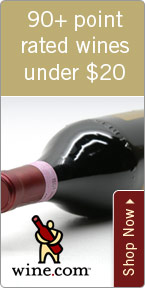Tasting And Describing Wines

Wednesday - May 19, 2006
| Share
 Del.icio.us
Del.icio.usI’ve often told people in the wine industry that when I first started, I thought that learning to smell and taste wine was the hardest thing to do. But it isn’t really the smelling and tasting of the wine that’s difficult. Everyone has a sense of smell and olfactory senses that tell you - unless you are impaired because of an injury - that you like chocolate better than strawberry, or that you like pork better than lamb.
Some people, of course, are more sensitive than others. But the hardest thing is actually taking everything your palate is sensing then putting them into words. Most people just aren’t used to doing that. They don’t have to write about a wine or sell it, they just know if they like it or not.
Here are some easy tips for you to become a better wine taster.
The most important sense we have in wine tasting is our sense of smell. In fact, without our sense of smell, we wouldn’t be able to taste almost anything at all. Have you ever tried to taste anything with a cold? It doesn’t taste very good, does it? So, how do you improve your sense of smell? Just be more aware of everything you smell every day.
Whenever I’m in the market or grocery store, I’m always picking up fruits and smelling them, especially ones I’ve never heard of or seen before. I also smell the fruit before I choose them. I figure if it smells ripe, it will taste ripe. Gardens, skin-care stores, especially the ones that have the different aromas separated, are a real treat for me. They help me to refine my sense of smell so that I’m accurate and can tell someone else exactly what I smell. And whenever I’m outdoors, I am always cognizant of the aromas around me. The earth and flora in the environment hold so many different aromas that you can pick up in wines, too: flowers, wet stone, grass. How cool is that?
A real dilemma for many people is deciphering if a wine is dry or sweet. Dry is the opposite of sweet; it’s a linear thing. Sweet drinks are those that have residual sugar. Things that we drink that have residual sugar are soda, fruit juices and energy drinks. The great majority of red wines are dry with only a few exceptions. White wines can come sweet or dry, but again most are dry.
Another thing that people have trouble describing is tannin. Tannin comes from the skin and pits of the grape, the stems of bunches as well as oak used in aging the wine. Tannin is that sometimes rough, palpable feeling that you get on your gums. Have you ever just chewed on the skin of a red grape or drunk some tea that was steeped too long? That feeling you get on your gums is tannin. Some like a lot of it, some don’t.
Tannin is often confused with acidity in a wine. The acidity in a wine makes your mouth pucker and salivate. The higher the acid, the more you feel it get close to your ears, your mouth waters more, you find yourself smacking your lips. Ever suck on a lemon or lime straight? That’s acidity.
Alcohol is pretty easy to pick up. It gives a wine a thicker viscosity or body and you can feel a warm, some say burning sensation. The longer you feel that sensation go down your digestive track, the higher the alcohol. If you feel it all the way to your stomach, it has high alcohol. So be careful.
I hope this helps explain how to taste and describe wines better. You’ll find that once you start verbalizing exactly what you are feeling and tasting, the more you can enjoy the wine, and the better chance you have of getting exactly the type of wine you want from your local wine merchant or at any restaurant.
Recommendations for pumping up your palate:
* 2004 Louis Latour Pouilly Fuisse $23. Dry, high acid, medium body, no tannin. Lightly earthy with wet stone, lots of pretty citrus elements, hinting toward orange blossom and pears. Very elegant, soft and great with an oven roasted chicken with rosemary and lemon.
* 2002 Groth Cabernet Sauvignon Napa Valley $60. Full-bodied, rich, dry, lower acidity, has plenty of tannin but is smooth. Ripe blackberry and currants, a touch of vanilla and cedar. Wonderful for steaks and ribs on the grill.
* 2003 Chalone Vineyard Pinot Noir $35. Medium body, medium and soft tannin, medium acidity and dry. Bunches of cherries, tea, vanillin and great with sautéed herb salmon with a squeeze of lemon.
Roberto Viernes is a master sommelier. E-mail .(JavaScript must be enabled to view this email address)E-mail this story | Print this page | Comments (0) | Archive | RSS Comments (0) |
Most Recent Comment(s):












